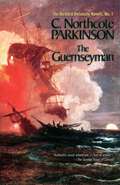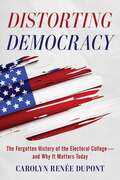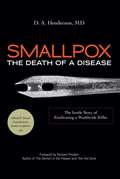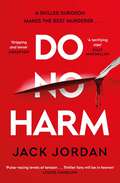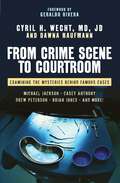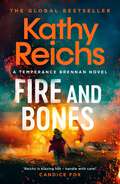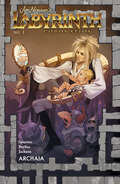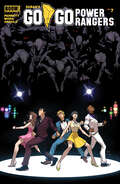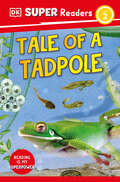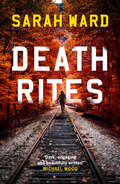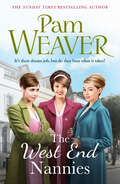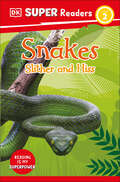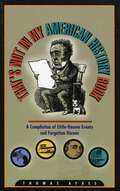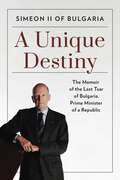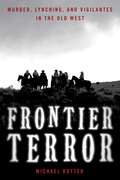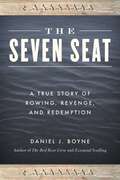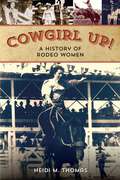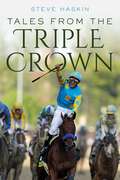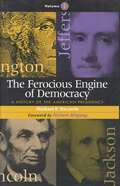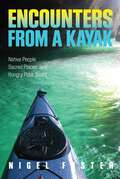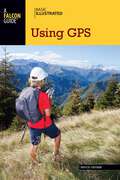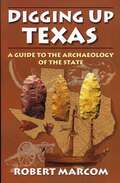- Table View
- List View
The Guernseyman
by C. Northcote ParkinsonRichard Delancey, inadvertently embroiled in Liverpool labor riots, sidesteps punishment by "volunteering" for the Navy. Ranked as a midshipman, he is no sooner aboard than his ship sails for the port of New York. But when the events of the American Revolution and the ongoing hostilities between England and France send him back across the sea, Delancey finds himself instrumental in defending the Isle of Jersey and, later, the Rock of Gibraltar.
Distorting Democracy: The Forgotten History of the Electoral College—and Why it Matters Today
by Carolyn Renée DupontThe complicated history of how America elects presidents and why this matters to the next election An engaging mix of history and political science, Distorting Democracy will awaken Americans to the perils of our system by unveiling the Electoral College&’s origins, history, and current problems. This book demonstrates that the system has no principled foundation, that it has changed dramatically over its 230–year history, and that it now threatens the legitimacy of our political system.The book is divided into three ground-breaking sections: Part I tells the story of the Electoral College&’s origins in the Constitutional Convention. Defenders of the Electoral College tend to invoke gauzy images of the Founding Fathers infusing our system with their unique, timeless wisdom. But history tells a very different story. The Founding Fathers faced a mess; they responded by creating a mess. Part II traces two hundred years of innovations—many of them subtle but highly consequential—to the plan described in the Constitution. As the new nation rapidly descended into bitter political conflict, many of the framers themselves, driven by their partisan interests, massaged the Electoral College into a form that differed profoundly from their founding intentions. Subsequent generations tinkered similarly with the systems&’ possibilities, always exploiting its potential for political gain. Part III examines how our strange presidential election system has produced frustrating results with increasing frequency in recent elections. Who can forget the Bush-Gore contest of 2000, when the results hinged on &“hanging chads&” and fewer than 1,500 votes in Florida? Americans endured weeks of a single-state recount, only to have the Supreme Court halt the process and hand the election to George W. Bush. Bush won the Electoral College by a single vote, but Al Gore captured 500,000 more popular votes. Then, in 2016, Donald Trump stunned the world with a substantial Electoral College victory of 302-227, though nearly 3 million more Americans preferred his opponent, and roughly 7 million voted for a third-party candidate.The system increasingly returns results that conflict with the expressed wishes of a majority of voters, a product of our hyper-polarized landscape and unique geopolitical distribution of party loyalists. The system cannot improve until we learn the complicated history of the Electoral College and the lessons it holds for us today."Every American should read this book. It brings facts and clarity to a debate that too often relies on conjecture about the Electoral College&’s purposes and ill-informed arguments about how it actually operates. The lessons herein are immense." -- Joshua A. Douglas, Ashland, Inc-Spears Distinguished Research Professor of Law, University of Kentucky
Smallpox: The Inside Story of Eradicating a Worldwide Killer
by D. A. Henderson M.D.For more than 3000 years, hundreds of millions of people have died or been left permanently scarred or blind by the relentless, incurable disease called smallpox. In 1967, Dr. D.A. Henderson became director of a worldwide campaign to eliminate this disease from the face of the earth. This spellbinding book is Dr. Henderson's personal story of how he led the World Health Organization's campaign to eradicate smallpox—the only disease in history to have been deliberately eliminated. Some have called this feat "the greatest scientific and humanitarian achievement of the past century." In a lively, engrossing narrative, Dr. Henderson makes it clear that the gargantuan international effort involved more than straightforward mass vaccination. He and his staff had to cope with civil wars, floods, impassable roads, and refugees as well as formidable bureaucratic and cultural obstacles, shortages of local health personnel and meager budgets. Countries across the world joined in the effort; the United States and the Soviet Union worked together through the darkest cold war days; and professionals from more than 70 nations served as WHO field staff. On October 26, 1976, the last case of smallpox occurred. The disease that annually had killed two million people or more had been vanquished–and in just over ten years. The story did not end there. Dr. Henderson recounts in vivid detail the continuing struggle over whether to destroy the remaining virus in the two laboratories still that held it. Then came the startling discovery that the Soviet Union had been experimenting with smallpox virus as a biological weapon and producing it in large quantities. The threat of its possible use by a rogue nation or a terrorist has had to be taken seriously and Dr. Henderson has been a central figure in plans for coping with it. New methods for mass smallpox vaccination were so successful that he sought to expand the program of smallpox immunization to include polio, measles, whooping cough, diphtheria, and tetanus vaccines. That program now reaches more than four out of five children in the world and is eradicating poliomyelitis. This unique book is to be treasured; a personal and true story that proves that through cooperation and perseverance the most daunting of obstacles can be overcome.
Wreckers: The Florida Keys (Florida Keys)
by John VieleIn this third book in a series on the history of the Florida Keys, John Viele tells the true story of the Florida Keys wreckers, the daring seamen who sailed out in fair weather or foul to save lives and property from ships cast up on the unforgiving Florida Reef in the passage south of the Florida Keys, one of the most dangerous in the world, having claimed thousands of ships and lives. In the 1850s, the heyday of the wreckers, ships were piling up on the reef at the rate of nearly one a week. Salvaging these wrecks was a highly competitive and hazardous gamble of the lives, limbs, and vessels of the wreckers against an often elusive gain. From the archives of the federal court at Key West, or &“wrecking court," and from contemporary letters, diaries, and newspaper articles, the author has captured the drama of the lives and times of the Florida Keys wreckers with accuracy and clarity. Richly illustrated with drawings from nineteenth-century magazines and newspapers, artists' concepts of wrecking scenes, and reproductions of old paintings and photographs, this book will fascinate sailors and landlubbers alike.See all of the books in this series
Do No Harm: the GRIPPING Sunday Times bestseller!
by Jack JordanA skilled surgeon makes the best murderer . . . * THE SUNDAY TIMES BESTSELLER * * WATERSTONES THRILLER OF THE MONTH * 'Chilling and perfectly paced, one to put on the very top of your TBR!' Sarah Pearse 'Thriller fans will be in heaven' Louise CandlishThe man lies on the table in front of me. As a surgeon, it&’s my job to save him. As a mother, I know I must kill him. You might think that I&’m a monster. But there really is only one choice. I must get away with murder. Or I will never see my son again.I&’VE SAVED MANY LIVES. WOULD YOU TRUST ME WITH YOURS?Readers can't get enough of Do No Harm . . . (***** five star reader reviews) &‘Absolutely phenomenal&’ &‘Kept me hooked from the very start!' &‘Believe me, you&’ll not want to put this down&’ &‘Everything about Do No Harm was absolutely brilliant' &‘So full of tension and twists!&’
From Crime Scene to Courtroom: Examining the Mysteries Behind Famous Cases
by Cyril H. Wecht Dawna KaufmannFrom crime scene to morgue to courtroom, and finally the court of public opinion, this riveting narrative is essential reading for true-crime enthusiasts. If you think the media has told you everything there is to know about Michael Jackson and Casey Anthony, think again! This engrossing, almost cinematic page-turner, offers never-before-published information on the mysterious deaths of Michael Jackson and Caylee Anthony, plus five other ripped-from-the-headlines criminal cases. Based on the authors' long investigative experience, these two insiders offer revealing insights into the following high-profile cases: -Casey Anthony: An assessment of the Trial of this Century, during which a Florida mother stood accused of killing her young daughter, Caylee. At stake were issues that included accuracy of air sampling and cadaver dogs, post-mortem hair banding, chloroform, duct tape identification, computer clues, and deep family secrets. -Michael Jackson: The authors provide never-disclosed data on the autopsies of Jackson's body and a microscopic view of the singer's life and career, plus analysis of the cardiologist charged with his death: Was Dr. Conrad Murphy recklessly negligent or a fall guy for a hopelessly addicted celebrity? -Drew Peterson: Heroic Illinois SWAT team cop or wife killer? Did his third wife slip and fall in the bathtub, or was she beaten and drowned? The controversy over her death led to an exhumation and the filing of homicide charges against him, but can prosecutors prove their case? And what happened to his fourth wife, who remains missing? -Rolling Stone Brian Jones: Was the rock musician's death an accident or something more sinister? And was he impaired by drugs or alcohol when he died? After more than forty years, there is finally an answer. In addition, the authors examine the tragic death of twelve-year-old Gabrielle Bechen, whose rape-murder changed her community; Col. Philip Shue, whose demise was a battle of suicide versus homicide until Dr. Wecht solved the case; and Carol Ann Gotbaum, a respected Manhattan mother who died in police custody in Phoenix.
Fire and Bones (A Temperance Brennan Novel #23)
by Kathy Reichs#1 New York Times bestselling author Kathy Reichs returns with a twisty, unputdownable thriller featuring forensic anthropologist Temperance Brennan, who finds herself at the centre of a Washington, D.C., arson investigation that spawns deepening levels of mystery and, ultimately, violence. Always apprehensive about working fire scenes, Tempe is called to Washington, D.C., to analyse the victims of a deadly blaze and sees her misgivings justified. The devastated building is in Foggy Bottom, a neighbourhood with a colourful past and present, and Tempe becomes suspicious about the property&’s ownership when she delves into its history. The pieces start falling into place strangely and quickly, and, sensing a good story, Tempe teams up with a new ally, telejournalist Ivy Doyle. Soon the duo learns that back in the thirties and forties the home was the hangout of a group of bootleggers and racketeers known as the Foggy Bottom Gang. Though interesting, this fact seems irrelevant – until the son of a Foggy Bottom gang member is shot dead at his home in an affluent part of the district. Coincidence? Targeted attacks? So many questions. As Tempe and Ivy dig deeper, an arrest is finally made. Then another Foggy Bottom Gang-linked property burns to the ground, claiming one more victim. Slowly, Tempe&’s instincts begin pointing to the obvious: somehow, her moves since coming to Washington have been anticipated, and every path forward seems to bring with it a lethal threat.
Jim Henson's Labyrinth: Coronation #1 (Jim Henson Presents #1)
by Simon SpurrierSimon Spurrier (Godshaper, The Power of the Dark Crystal) and Daniel Bayliss (Jim Henson’s Storyteller: Dragons, Kennel Block Blues) present a magical look into the world of Jim Henson’s Labyrinth. Before Sarah braved the Labyrinth to save her brother, another young woman sought to save a young boy named Jareth from the clutches of the Goblins. Set in 18th-century Venice, Italy, Jim Henson’s Labyrinth is a striking look into the history of the Labyrinth itself, and what happens to the little boys who don’t get rescued. This is the untold history of the Goblin King.
Saban's Go Go Power Rangers #7 (Saban's Go Go Power Rangers #7)
by Ryan ParrottIt's homecoming at Angel Grove! But as tensions run high amongst the Rangers, will they be able to band together to stop Rita and make it to the dance on time?
DK Super Readers Level 2 Tale of a Tadpole (DK Super Readers)
by DKHelp your child power up their reading skills and learn all about a tadpole’s growth into a frog with this fun-filled nonfiction reader carefully leveled to help children progress.DK Super Readers Level 2: Tale of a Tadpole will introduce kids to a tadpole’s life in a pond as it transforms into a frog—including fun facts from how it develops to what it eats—and is a motivating introduction to using essential nonfiction reading skills, proving ideal for children ready to enter the riveting world of reading. DK Super Readers take children on a journey through the wonderful world of nonfiction: traveling back to the time of dinosaurs, learning more about animals, exploring natural wonders and more, all while developing vital nonfiction reading skills and progressing from first words to reading confidently. The DK Super Readers series can help your child practice reading by:- Covering engaging, motivating, curriculum-aligned topics.- Building knowledge while progressing key Grades 2 and 3 reading skills.- Developing subject vocabulary on topics such as tadpoles, frogs, and animals.- Boosting understanding and retention through comprehension quizzes.Each title, which has been leveled using MetaMetrics®: The Lexile Framework for Reading, integrates science, geography, history, and nature topics so there’s something for all children’s interests. The books and online content perfectly supplement core literacy programs and are mapped to the Common Core Standards. Children will love powering up their nonfiction reading skills and becoming reading heroes. DK Super Readers Level 2 are visually engaging and expand subject knowledge and vocabulary for young readers who want to learn more about the world around them. Perfect to help children ages 7 to 9 (Grades 2 and 3) beginning to read independently.
Death Rites: A dark and atmospheric crime thriller (Carla James Crime Thrillers)
by Sarah WardFresh, original and utterly compelling' Marion Todd A calculated killer. A town under threat. An unfinished pattern... Archaeology professor Carla James is reeling following the death of her husband. Desperate for a change of scene, she takes a job at an elite New England college. On her first day, Carla is asked to represent the department at a murder site. She initially believes there is nothing notable about the scattered debris that surrounds the body, but there is more to the case than meets the eye. This victim is just the latest in a series of unsolved deaths. Nothing obvious links them but Carla is convinced – there is a methodical killer operating in the shadows. Can she uncover the truth before she becomes the next victim? A dark and tense crime thriller. Perfect for fans of Kathy Reichs and Elly Griffiths. Praise for Death Rites 'A clever and compelling crime thriller' Woman's Weekly 'A gripping, atmospheric page-turner of a novel. If you like Elly Griffiths' Ruth Galloway series, you'll love this!' Sheila Bugler 'Different, eerie and completely engrossing' Kate Griffin 'A compulsive page-turner of a thriller, rich in the atmosphere and folk mythology of New England' Philip Gwynne Jones 'I could not put it down! Sarah Ward captures the claustrophobia of a small town perfectly and the characterisation was outstanding' Rachel Lynch 'Strongly atmospheric... A fast and moody read with a determined heroine and an evocative setting' Crime Time 'Gripping and had me on the edge of my seat… I adored Carla!' ***** Reader review 'I loved how the characters developed through the story… All the subplots are woven together to form a dramatic conclusion' ***** Reader review 'A strong start to the Carla James Crime Thrillers series… suspenseful and kept me guessing' ***** Reader review 'A good story… well-written with well developed characters' ***** Reader review 'Gripping from the very first page… reminiscent of Elly Griffith's Ruth Galloway novels in that the main protagonist is an archaeologist and Carla is every bit as plucky and intelligent as Ruth!' ***** Reader review
The West End Nannies: An emotional, uplifting 1960s saga (The West End Nannies)
by Pam WeaverJenny starts her training as a nanny, but does she have what it takes – and will her family survive without her? It is 1962 and 17-year-old Jenny is finally able to train for her dream job as a nanny. The residential training is tough – Matron takes no prisoners but Jenny bonds with her two roommates, Bernice and Rita, and loves helping the children. If only her family life could be so happy – her brother, Maurice, is a wrong'un and seems to have some hold over her father, and Jenny has never got over the sudden disappearance of her mother. Finally, Jenny gets her first nanny job, heading for the bright lights of London at the dawn of the Swinging Sixties. Suddenly she is thrust into the lifestyle of the rich at a household in the affluent West End, working for a family whose busy lifestyle means that their child is neglected. Can Jenny heal their family - and her own? Readers adore this story and can't wait for more in the series: ‘A great story with great characters, can’t wait to read more.’***** Reader Review ‘Brilliantly written, loved this book, highly recommended.’***** Reader Review ‘I loved this book, most of the historical fiction I read is set much earlier so it was a delight to learn more about life in the 60's.’***** Reader Review ‘A brilliant start to a new series! I absolutely loved it. Looking forward to the next one already!’***** Reader Review ‘A delightful look at England in the 1960s and the world of private Nannies… I can’t wait for the next one!’***** Reader Review ‘I was engaged from the start.’***** Reader Review ‘I really loved this story.’***** Reader Review ‘I loved reading this story and hopefully will get more about the nannies in future books.’***** Reader Review ‘A joy to read.’***** Reader Review ‘This had all the things we want from a book like this: the heart, the emotions, the plot and pacing. it was all woven together in exactly the right ways.’***** Reader Review
DK Super Readers Level 2 Snakes Slither and Hiss (DK Super Readers)
by DKHelp your child power up their reading skills and learn all about slithering, scaly snakes with this fun-filled nonfiction reader carefully leveled to help children progress.DK Super Readers Level 2: Snakes Slither and Hiss will introduce kids to many different amazing snakes – including facts from how a snake hatches and how it moves to where it lives and how it attacks its prey – and is a motivating introduction to using essential nonfiction reading skills, proving ideal for children ready to enter the riveting world of reading. DK Super Readers take children on a journey through the wonderful world of nonfiction: traveling back to the time of dinosaurs, learning more about animals, exploring natural wonders and more, all while developing vital nonfiction reading skills and progressing from first words to reading confidently. The DK Super Readers series can help your child practice reading by:- Covering engaging, motivating, curriculum-aligned topics.- Building knowledge while progressing key Grades 2 and 3 reading skills.- Developing subject vocabulary on topics such as animals, snakes, and how snakes attack their prey.- Boosting understanding and retention through comprehension quizzes.Each title, which has been leveled using MetaMetrics®: The Lexile Framework for Reading, integrates science, geography, history, and nature topics so there’s something for all children’s interests. The books and online content perfectly supplement core literacy programs and are mapped to the Common Core Standards. Children will love powering up their nonfiction reading skills and becoming reading heroes. DK Super Readers Level 2 are visually engaging and expand subject knowledge and vocabulary for young readers who want to learn more about the world around them. Perfect to help children ages 7 to 9 (Grades 2 and 3) beginning to read independently.
That's Not in My American History Book: A Compilation of Little-Known Events and Forgotten Heroes
by Thomas AyresHistory classes reduce America's story into a dry litany of dates, names, and places. That's Not in My American History Book tackles the messy details, reclaims disregarded heroes, and sets the record straight. This book explains why July 4th isn't really Independence Day, reveals 19th century mudslinging that labels Andrew Jackson a "murderer," and even unveils the only vice president with a number-one pop hit. With insight, wit, and irreverence, Ayres uncovers our overlooked past.
Marching for Union: A Civil War Soldier's Walk across the Reconstruction South
by Randy BishopIn January 1868, a Union veteran named Gilbert Bates set out from his Wisconsin farm for Vicksburg, Mississippi, to prove a point and win a bet: that he could safely walk across the post–Civil War South—alone, unarmed, with no money—while carrying the flag of the United States. The effort quickly riveted the attention of Americans everywhere, who weren&’t yet sure the country could meaningfully reunite after their fratricidal war. Mark Twain believed Bates would be abused, attacked, possibly even scalped, during this time when the U.S. Army still occupied the South, resentment ran high, and groups like the KKK were spreading terror.Starting from Vicksburg, Bates walked 1,400 miles through Mississippi, Alabama, Georgia, South Carolina, North Carolina, and Virginia, through places where Federal soldiers shattered Confederate arms and Sherman&’s men razed the land. He was never harmed—and almost always greeted with hospitality, generosity, and celebration. En route, Bates planned to sell photos of himself with the Stars and Stripes to raise money for widows and orphans and eventually called off the bet, which he would&’ve lost on a technicality: even though he successfully traveled the South unharmed and reached Washington, DC, in the agreed-upon timeframe, he was not allowed to raise his flag above the U.S. Capitol and had to settle for the unfinished Washington Monument.This is a deeply researched book that taps into big- and small-town newspaper coverage that described Bates&’s journey across the American South and his reception. It recounts the courage of a former soldier who believed strongly in the bonds of Union and Lincoln&’s &“mystic chords of memory&” and underscores the missed opportunities for a more perfect union.
A Unique Destiny: The Memoir of the Last Tsar of Bulgaria, Prime Minister of a Republic
by Simeon II of BulgariaDuring World War II, most of Europe&’s last monarchies collapsed. Under Tsar Boris III, Bulgaria had been a reluctant ally of Hitler&’s Germany, refusing to send troops to fight the Soviets and resisting the Holocaust. But after Boris died in 1943, the Red Army entered the country, and communists executed much of the royal family and sent the boy-tsar, Simeon II, into exile, first to Turkey and Egypt, then to Spain. In 2001, Simeon was elected prime minister of Bulgaria in a landslide that swept out the country&’s two major parties. The crown jewel of his time in power was bringing Bulgaria into NATO. He peacefully left power in 2005.In the first English translation of this colorful memoir, Simeon—the world&’s last tsar and one of two living heads of state from World War II (with the Dalai Lama)—recounts with honesty and humor an eventful life from Bulgaria to Spain and the United States, and back to Bulgaria, and into the world. His life&’s story includes crossing paths with Queen Elizabeth II of England, the Shah of Iran, General Franco of Spain, Hassan II of Morocco, and many other royalty, as well as helping to integrate Bulgaria into a new democratic global system.
Frontier Terror: Murder, Lynching, and Vigilantes in the Old West
by Michael RutterFollowing the events of January 6, 2021, talk of vigilantes and mob violence have become a part of our daily discourse, reminding us that we haven&’t come as far as we thought from the &“wild&” days of the Old West. The nineteenth century was a time of opportunity in the West, but it was also fraught with lawlessness, racism, and extreme violence as territories became states, freemen and immigrants settled alongside white homesteaders, and the first unions changed the way we work. Author Michael Rutter examines the growing pains of the American West through the lens of nineteenth- and early twentieth-century vigilantes, outlaws, mob violence, and lynchings, proving that oftentimes our country&’s democratic progress comes at the cost of physical violence.
The Seven Seat: A True Story of Rowing, Revenge, and Redemption
by Daniel J. BoyneHarvard University coach and acclaimed rowing author, Dan Boyne, tells a humorous story of his first year of freshman crew, including a sub plot of personal redemption against an insufferable football player who has bullied him throughout high school.After being accepted at Trinity College in Hartford, CT, Boyne decides to take up rowing, the only sport that takes place far off campus, on the adventurous waters of The Connecticut River. There, he quickly experiences the unique rigors, rewards, and colorful personalities of the sport, not knowing that his nemesis has decided to try out for crew, at rival school Coast Guard Academy. As racing season approaches, Boyne becomes part of an exceptional freshman lightweight boat, with high hopes to win the National Championships in Philadelphia that year, but his final fears are realized when he discovers that his old high school archenemy is also doing well, and rowing in the very same position as he is—the seven seat.The authors previous book, The Red Rose Crew earned a starred Kirkus review and became a Boston Globe bestseller in 2001., In 2008, Dan was awarded first prize in the category of biography in the Premier Book Awards for Kelly., Motion picture rights for The Red Rose Crew have been sold, and the script is now being written.
Cowgirl Up!: A History of Rodeo Women
by Heidi ThomasWhen someone says "Cowgirl Up!" it means rise to the occasion, don't give up, and do it all without whining or complaining. And the cowgirls of the early twentieth century did it all, just like the men, only wearing skirts and sometimes with a baby waiting behind the chutes. Women learned to rope and ride out of necessity, helping their fathers, brothers, and husbands with the ranch work. But for some women, it went further than that. They caught the fever of freedom, the thirst for adrenaline, and the thrill of competition, and many started their rodeo careers as early as age fourteen. From Alice and Margie Greenough of Red Lodge, whose father told them &“If you can&’t ride &’em, walk,&” to Jane Burnett Smith of Gilt Edge who sneaked off to ride in rodeos at age eleven, women made wide inroads into the masculine world of rodeo. Montana boasts its share of women who &“busted broncs&” and broke ranks in the macho world of rodeo during the early to mid-1900s. Cowgirl Up! is the history of these cowgirls, their courage, and their accomplishments.
Tales from the Triple Crown
by Steve HaskinIn Tales from the Triple Crown, award-winning racing writer Steve Haskin takes readers behind the scenes to introduce them to the trainers, jockeys, and horses seeking the world&’s most elusive sports prize. Feel the keen disappointment of trainer Bud Delp after Spectacular Bid loses his Triple Crown bid because of a stray safety pin. Witness Angel Cordero&’s frustration after winning the Kentucky Derby aboard Spend a Buck, only to encounter a series of misadventures on his way home. Mourn the untimely loss of Barbaro in a Preakness that shook the racing world. Their stories are among the twenty-four—including three that are new to this paperback edition—that bring a new dimension to the repertoire of Kentucky Derby, Preakness, and Belmont Stakes reporting.Horse racing is no stranger to triumph and tragedy, and in Tales from the Triple Crown Haskin shares both the adrenaline charge of victory and the disappointment of close losses. Haskin&’s personal involvement, keen eye for a good story, and engaging writing style make readers feel like they are living the moments with him.
Ferocious Engine of Democracy: A History of the American Presidency
by Michael P. RiccardsOpinions will vary widely on all the presidents, but this work will make those opinions more penetrating and judicious.— James MacGregor Burns
Encounters from a Kayak: Native People, Sacred Places, and Hungry Polar Bears
by Nigel FosterWhat makes travel special? Perhaps the chill realization that a polar bear's eyes are fixed on you. Maybe it is the chance meeting with a man who buries sharks in a beach, only to dig them up months later, not out of morbid curiosity, but for food. Perhaps it is the undulating wing-beat of a dark shell-less gastropod in the canal of a 17th Century French sea port, or the criminal history of a rusting ship with a tree growing from its hold.Encounters in a Kayak brings the reader along on the magical experiences that surround sea kayaking. It&’s about the animals, people, and special places around the globe that have grabbed the attention of renowned kayaker and writer Nigel Foster. His irrepressible curiosity drives him to tease out the unexpected stories hidden behind his subjects. These nuggets from around the world are bound together by water and a centuries-old form of sea travel: kayak. The result is a book of broad appeal for those interested in kayaking, traveling, and adventure.
Shocktober: The Biggest Upsets in World Series History
by Jonathan WeeksBaseball&’s October showcase has provided some high drama over the years. Willie Mays&’s spectacular catch in 1954, Bill Mazeroski&’s walk-off homer in 1960, and Kirk Gibson&’s pinch-hit blast in 1988 are just a few of the memorable moments that have dominated highlight reels. The outcome of the Series has not always been terribly surprising—especially during the late 1940s and early 1950s when the Yankees captured five consecutive championships, breaking their previous record of four straight titles from 1936 to 1939. But in spite of its predictability at times, the Fall Classic has taken many unexpected turns. The 1906 Cubs lost to the weak-hitting White Sox after establishing a new regular season record for wins. The 1955 Dodgers avenged seven prior October failures with an improbable victory over the seemingly invincible Yankees. And in 1969, the Mets finally shed their image as &“loveable losers,&” dethroning the powerful Orioles. In more than a century of World Series plays, a number of similar scenarios have emerged. Twenty-two of those stories are told in Shocktober. The book also includes an appendix of game statistics as well as a section on World Series trivia.
Basic Illustrated Using GPS (Basic Illustrated Series)
by Bruce GrubbsRichly illustrated and information-packed tools for anyone whose play or work takes them to remote areas. Basic Illustrated Using GPS, 3rd is a guide to practical field use of the Global Positioning System, written in simple language, with each new term explained as it's used. This book is a wealth of useful backcountry navigation advice for beginners and experts alike. It also includes information on using GPS with the latest mapping software.Disocver how to:Pick the best GPS receiver for your specific needsRead and pregrid topographic mapsIdentify waypoints with various coordinate systemsUse GPS to navigate on land and waterCreate your own maps with GPS software
Digging Up Texas: A Guide to the Archaeology of the State
by Robert MarcomTake a guided tour of more than 15,000 years of life in TexasMr. Marcom has authored a volume that makes the incredibly diverse archaeological record of Texas accessible to interested laypersons and beginning avocational archaeologists.
